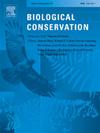采矿在当地和景观尺度上重塑了动物群落
IF 4.9
1区 环境科学与生态学
Q1 BIODIVERSITY CONSERVATION
引用次数: 0
摘要
人为干扰,如采矿,极大地改变了景观,并可能对生态系统和其中的野生动物产生负面影响。本文研究了采矿营地(采矿景观中的半城市居住区)对野生动物群落的生态影响,包括物种组成和多样性、生态系统功能、捕食者-猎物网络和时间活动。采用分布式控制影响设计,我们在西澳大利亚皮尔巴拉地区的采矿营地和生态相似的参考景观中部署了相机陷阱。我们发现在采矿营地的物种组成有明显的差异,这表明形成了新的组合。尽管矿区生态系统具有高度的功能冗余,可能缓冲未来干扰的影响,但矿区生态系统的功能分散程度较低,表明物种在这里执行的生态功能变化较少。采矿营地的捕食者-猎物网络总体结构与参考景观相似,尽管物种组成存在重大差异。然而,采矿营地较低的网络连接表明,食物网更容易受到未来干扰或物种丧失的影响。动物的行为反应包括一些动物群体的时间活动改变,捕食者的变化和采矿营地的竞争压力。某些动物群体(如澳洲野狗、野生食草动物)对干扰的适应能力更强,而采矿营地的局部影响突出了不同规模的干扰的不同影响。这些结果表明,人类干扰对动物群落和生态系统的影响是复杂的,在进行景观改造管理时需要考虑社区范围的方法。本文章由计算机程序翻译,如有差异,请以英文原文为准。
Mining reshapes animal communities at a local and landscape-scale
Anthropogenic disturbances, such as mining, significantly modify landscapes and can have negative effects on ecosystems and the wildlife therein. Here, we investigate the ecological impacts of mining camps (semi-urban accommodation areas in mining landscapes) on wildlife communities, including for species composition and diversity, ecosystem function, predator-prey networks, and temporal activity. Using a distributed control-impact design, we deployed camera traps at mining camps and ecologically similar reference landscapes across Western Australia's Pilbara region. We found a marked difference in species composition at mining camps, suggesting the formation of novel assemblages. Lower functional dispersion at mining camps suggests that the ecological functions being performed by species here are less varied, although ecosystems at mining camps have high functional redundancy, likely buffering the effects of future disturbance. Predator-prey networks at mining camps had similar overall structure to reference landscapes despite major differences in species composition. However, lower network connectance at mining camps suggests that food webs are more vulnerable to future disturbance or species loss. Behavioural animal responses included altered temporal activity by some animal groups, shifting predator and competition pressures at mining camps. Certain animal groups (e.g., dingoes, feral herbivores) were more resilient to disturbance, while localised effects at mining camps highlight the differing influences of disturbance at different scales. These results demonstrate the complex impacts of human disturbance on animal communities and ecosystems, and the need to consider community-wide approaches when undertaking management in modified landscapes.
求助全文
通过发布文献求助,成功后即可免费获取论文全文。
去求助
来源期刊

Biological Conservation
环境科学-环境科学
CiteScore
10.20
自引率
3.40%
发文量
295
审稿时长
61 days
期刊介绍:
Biological Conservation is an international leading journal in the discipline of conservation biology. The journal publishes articles spanning a diverse range of fields that contribute to the biological, sociological, and economic dimensions of conservation and natural resource management. The primary aim of Biological Conservation is the publication of high-quality papers that advance the science and practice of conservation, or which demonstrate the application of conservation principles for natural resource management and policy. Therefore it will be of interest to a broad international readership.
 求助内容:
求助内容: 应助结果提醒方式:
应助结果提醒方式:


